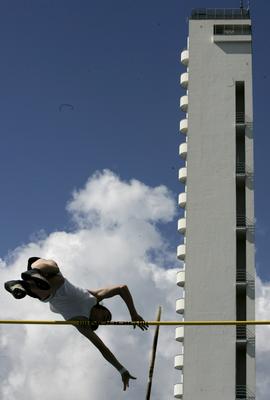Architecture + Sport
dal 31/5/2006 al 2/9/2006
Segnalato da
31/5/2006
Architecture + Sport
Pinakothek der Moderne, Munich
The exhibition aims on the one hand at illustrating the evolution and variety of architecture associated with sports arenas and on the other at showing through a series of achievements in master building how sports stadiums are being used more and more to experiment with new constructions and ways of developing building design.

From antique stadiums to modern arenas
Featuring prominently in Germany’s sporting year 2006 is the FIFA World Cup.
To mark this event, the Architecture Museum of the TU Munich is holding an
exhibition entitled >>Architecture+Sport. From stadiums of the antiquity to
the modern arena<<. It provides a multi-facetted insight into the history,
development, significance and construction of sports sites and complexes.
Games and tournaments have been an important part of social activity ever
since the antiquity. They have adapted to changes in society, responding to
its ideals and ideologies; this makes sports arenas not only indicators of
architectural progress but also a reflection of social, cultural and
political change.
The exhibition begins with an overview of the history of sports sites. It
takes visitors from stadiums of the antiquity and arenas such as the
Colosseum in Rome or the Byzantine Hippodrome, to sites of medieval
tournaments, ball grounds of early modern times and to gymnasiums and sports
facilities for workers and the broad public in the 19th and 20th century.
Models, drawings, engravings, paintings and photos all document the
emergence of different kinds of sport and sports arenas.
The second part of the exhibition shows how sport and the building of sports
facilities gained increasing social relevance in the course of the 20th
century. Sport has become both a means of national identification in mass
societies and also the overarching element of internationalisation reaching
out beyond nations. On a major scale, sport is turning into a powerful
economic factor and influential media event. Leading works like those of Le
Corbusier, Pier Luigi Nervi, Kenzo Tange, Renzo Piano and Zaha Hadid best
illustrate the growing significance and symbolism of sports arenas.
The spectrum of developments in sports architecture is particularly well
demonstrated in complexes built for the Olympic Games, starting with the
first Olympics in Athens in 1896 and going right through to plans for the
Games in Peking in 2008 and London in 2012.
The building of sports facilities as a way of experimenting with
constructions and technology is presented and explained in the third part of
the exhibition. The media presence of sport and the enormous investments
involved in building sports arenas are increasingly inspiring architects to
come up with innovative constructions: new support structures and moving
roofs with spectacular dimensions and effects are being tried out and put
into practice. Munich’s Allianz Arena of Herzog & de Meuron, the Wembley
National Stadium of Norman Foster, the Stadion of Souto de Moura in Braga or
the NatWest Media Center of Future Systems in London are just a few examples
of modern arenas whose original models are on display.
Animated films provide an insight into future building projects, while old
film excerpts illustrate major events in sporting history.
Accompanying the exhibition is an Edition Minerva publication with essays by
experts on architecture, construction and sporting history. (224 pages and
some 200 pictures, mainly in colour, price 20 Euro).
The exhibition is supported by the foundation Stiftung Pinakothek der
Moderne.
Opening hours: Daily except Tue 10.00 - 17.00 Wed 10.00 - 20.00
Pinakothek der Modene
Barer Strasse 29 - Munich



